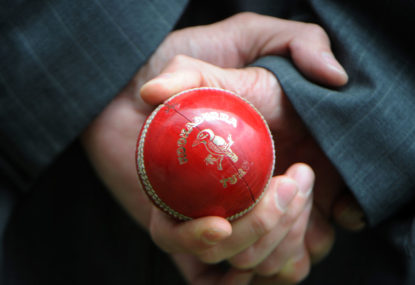WATCH; IPL bowler fuming after getting robbed of near-certain wicket by... Spider-Cam
Harshal Patel was not a happy man!

If there’s one thing I hate, it’s England getting the jump on Australia. Whether it’s the Ashes, the Commonwealth Games, or Eurovision, it is unacceptable to me for my country to ever finish behind the Poms.
This goes for matters of innovation just as much as matters of competition. So it’s deeply disappointing that the England Cricket Board has announced plans for a new 100-ball version of cricket, leaving the rest of the world floundering in the dark ages of Twenty20 like a bunch of mud-eating peasants.
The 100-ball version is an ingenious creation, whereby each team gets 15 overs, plus a ten-ball “over” to be bowled at the fielding team’s discretion, thus satisfying all the mums and kids who have spent years refusing to get involved in cricket because twenty overs per side was not only too long, but too uniform and not metric enough.
The ECB expects a massive influx of new players after their 100-ball format gets off the ground, and you can’t deny that’s pretty cute.
It seems like England is always coming up with new ways to play cricket: they were the ones who came up with the idea of playing with three stumps, they were the ones who came up with the idea of limited-overs games, they were the ones who came up with the idea of Phil Tufnell, and so forth.
Yet what has Australia’s contribution to the advancement of the game been? Besides personal abuse, I mean?
I believe it is time for Australia to devise a new form of cricket to compete with the excitement and fun of the 100-ball game. I have a humble suggestion of my own: I call it OzBall, but we can workshop the name. Basically it goes like this:
The number of balls available to each team to be determined beforehand by the Quiz Round.
In OzBall, each innings can be anywhere between five and fifty overs long, depending on how well the team does in the Quiz Round. The teams will have to answer 100 questions on the laws and history of cricket, with whichever team buzzes in first getting the chance to answer. Every correct answer gives your team an over, while every incorrect answer takes an over away.
Every member of the team must bowl.
All eleven members of the fielding side must bowl at some point during the innings. If the innings is less than eleven overs long, this will mean changing bowlers mid-over.
If a bowler bowls a wide or no-ball, the next ball must be bowled with the non-dominant hand.
Right-armers must bowl with the left arm, left-armers with the right, the delivery immediately after a wide or no-ball. This only applies to front-foot no-balls, however: if a no-ball is called for a high full-toss, the batsman is allowed to hit the bowler in the stomach with his bat.
Fours are now worth six, sixes are now worth eight.
Crowds like fast scoring, and this is why OzBall will be the fastest-scoring of all formats.
Not only will every shot that reaches the rope be worth six, and every shot over the rope worth eight, a batsman can score ten if he lands a shot in the second tier of seats or higher, and a twelve if he hits a spectator in the face.
Conversely, if a spectator catches a batsman’s shot, he is out, and suspended for three games. Batsmen can also score five runs for every time they hit an umpire.
Powerplays are supercharged for maximum excitement.
Unlike the staid, predictable state of powerplays in the modern game, OzBall introduces some real thrills to the mix.
The first powerplay lasts from the first ball of the innings to the ninth, and during it no fielders are allowed outside the circle.
The second powerplay goes from the tenth ball to the twenty-first, during which no fielders are allowed inside the circle.
From ball twenty-two to ball twenty-four, all fielders must be on the legside. For the forty balls after that, fielders can be placed anywhere, but must have weights tied to their ankles.
After that there are no fielding restrictions, but also no restrictions on members of the batting team physically restraining fielders in the course of their duties.
That is, up till the final over, which is known as the Ultra Powerplay: during this stage all fielders must be on their knees.
Bonuses for great catches.
To encourage athletic fielding, great catches will be worth more than ordinary ones. A catch taken with both feet off the ground not only dismisses the batsman, but wipes five runs off the batting total.
A catch taken after a fielder leaps over the boundary and tosses the ball back inside the rope dismisses both batsmen currently on the field.
A catch taken with one hand means the batsman must bat for the next ten minutes with a miniature bat. A catch taken in a hat ends the innings.
A catch taken with the mouth sends the batsman to prison for six months.
Thrilling player movements.
To keep interest in the competition at fever pitch, every OzBall franchise must replace their entire playing roster every three games.